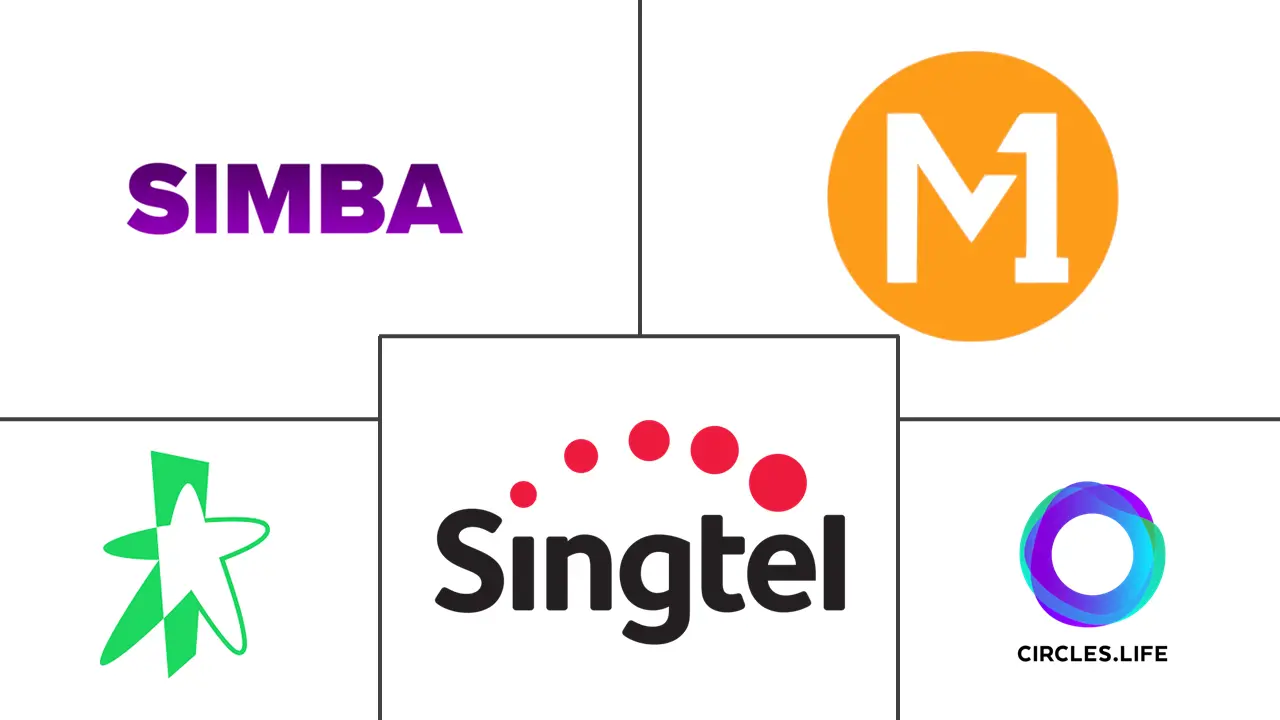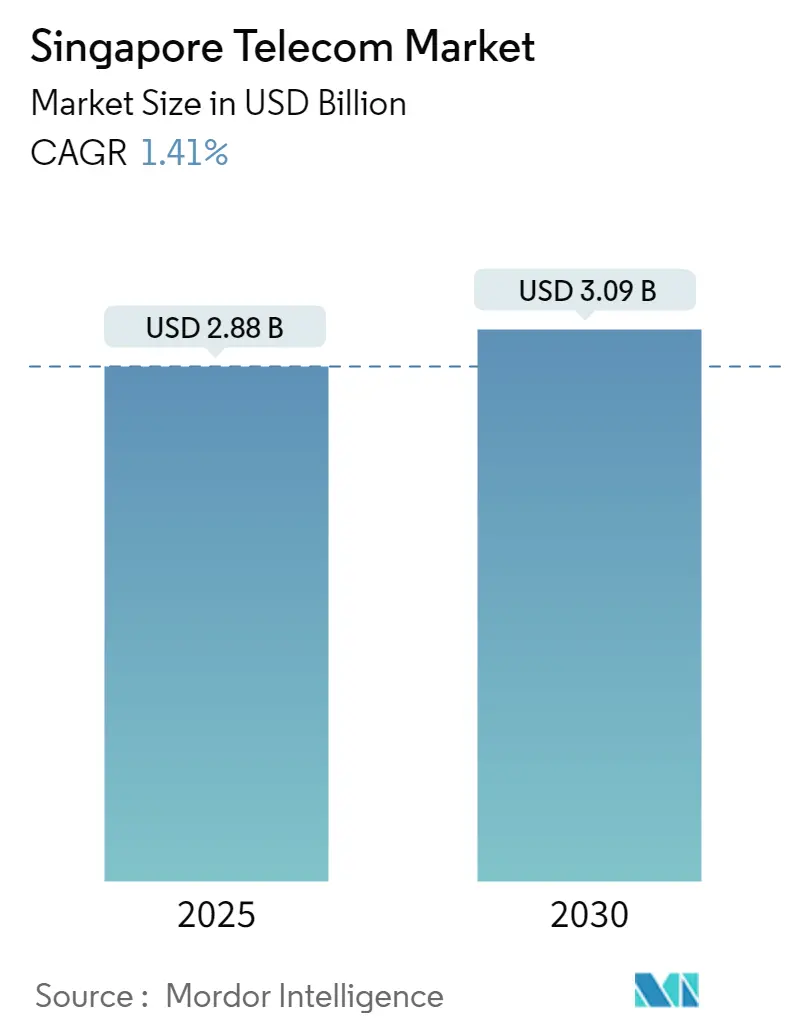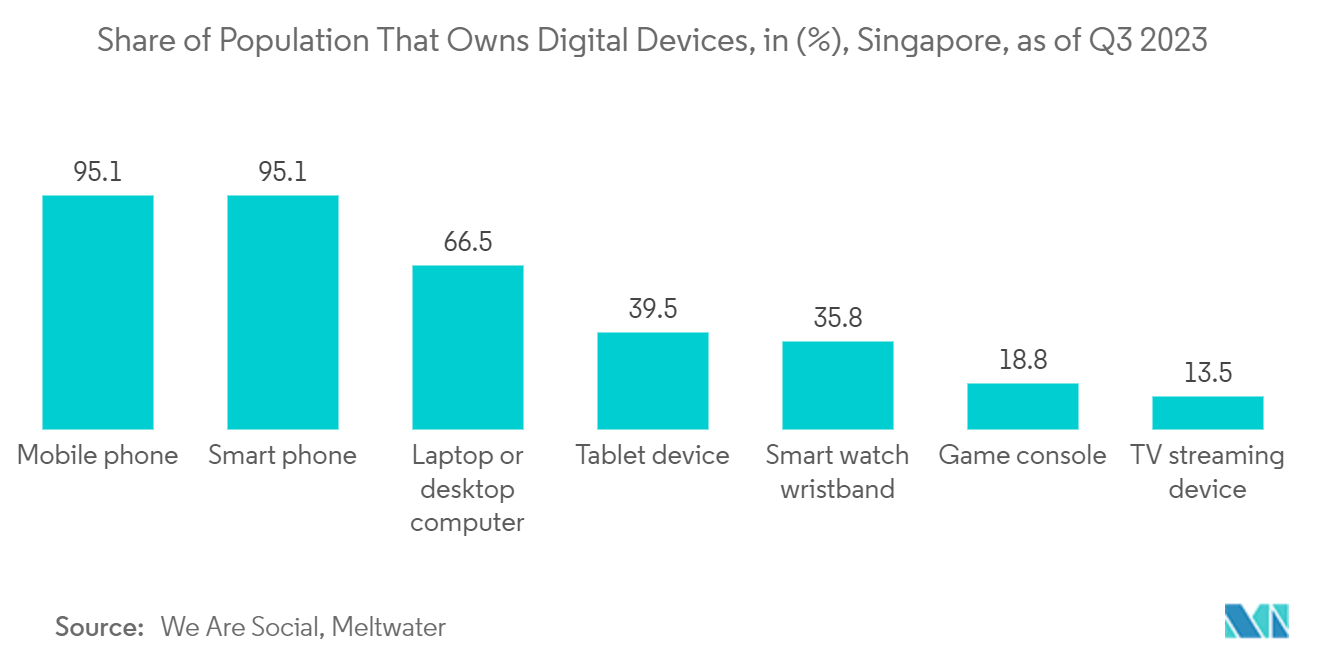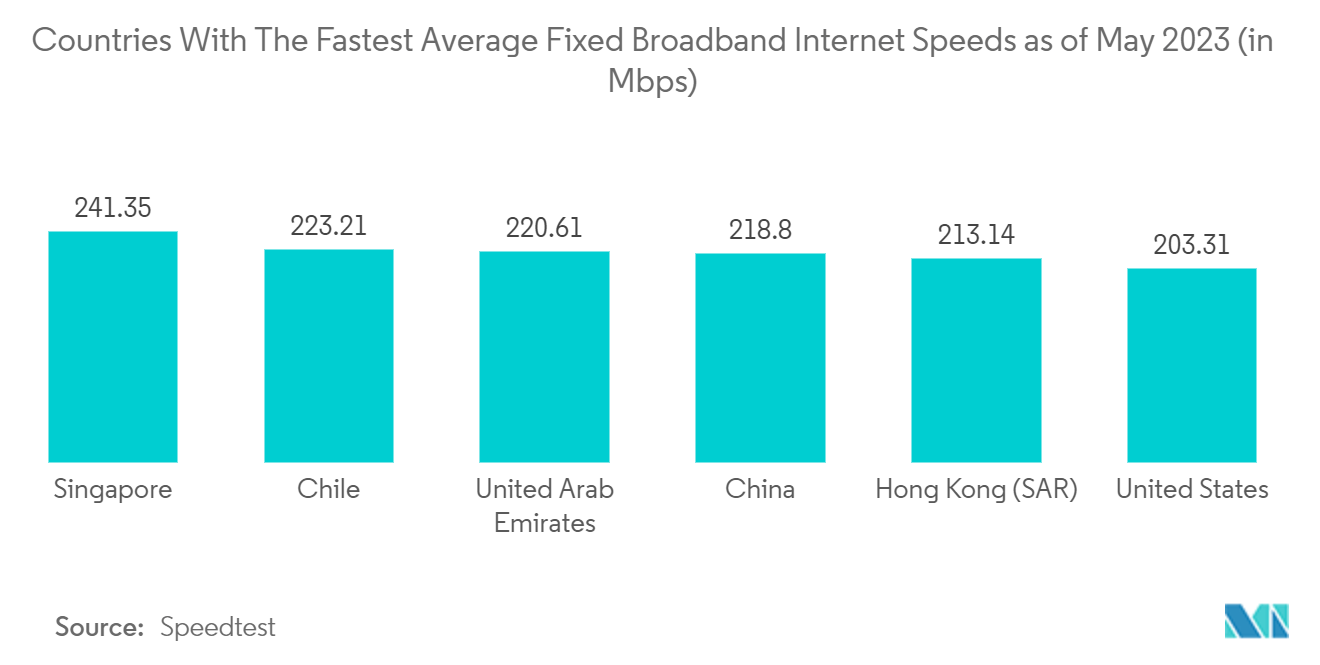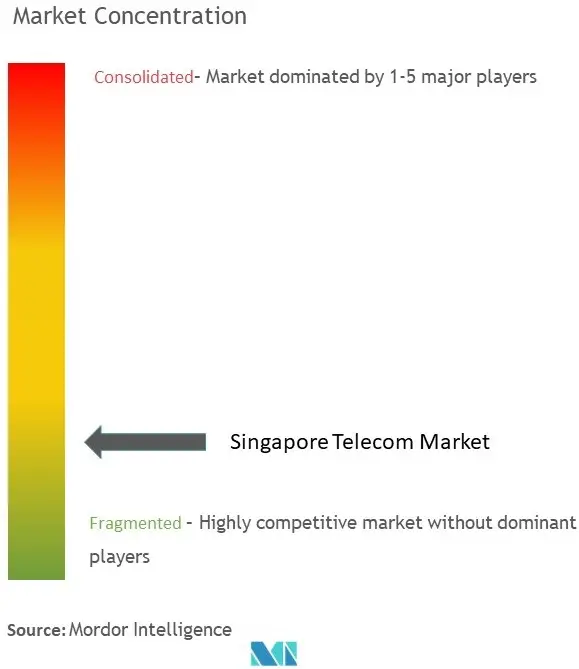Singapore Telecom Market Analysis
The Singapore Telecom Market size is estimated at USD 2.88 billion in 2025, and is expected to reach USD 3.09 billion by 2030, at a CAGR of 1.41% during the forecast period (2025-2030).
The country's telecommunication industry is dominated by companies such as Singapore Telecommunications Limited (Singtel), StarHub Limited, and M1 Limited. The market has grown due to robust 5G networks and demand for wireless networks. In addition, in Singapore, there are approximately 7,140 towers, in which existing MNOs have towers island-wide that allow it to meet IMDA's QoS standard, with Singtel leading at 99.9% of outdoor coverage, followed by StarHub and M1 at 99.4%. According to TowerXchange, there are approximately 1,000 greenfield and 5,750 rooftop sites.
The country has the highest internet penetration rates globally, with over 90% of its residents having internet access. The nation's internet speed is also among the fastest in the world, with an average speed of more than 200 Mbps. The high level of internet connectivity has impacted the country's society and economy, supporting the growth of several industries, such as fintech, e-commerce, and digital media. This growth is anticipated to be driven by operators' continuing investments in 5G network development and investments in developing digital infrastructure in the nation to expand fixed broadband connectivity. As per IMDA, by December 2023, Singapore boasted approximately 1.86 million 5G mobile subscriptions, marking a substantial surge from the previous decade.
Singapore boasts one of the most advanced telecom infrastructures in the world, including widespread fiber-optic networks and extensive 5G coverage, facilitating robust growth in the telecom industry. For instance, in April 2024, Singtel collaborated with Huawei and announced 'FibreEverywhere.' This innovative home broadband solution showcases Huawei's advanced transparent fiber optic cables. These cables promise high-speed and exceptionally reliable internet connections, extending their reach to devices like laptops and smartphones in every corner of the house, a first move in Singapore.
Furthermore, the Singaporean government supports the telecom industry through policies and initiatives to foster innovation and infrastructure development, such as the Infocomm Media Development Authority (IMDA) initiatives. Also, Singapore's Smart Nation initiative aims to leverage technology to improve the quality of life, creating a demand for advanced telecom services to support innovative infrastructure, digital government services, and IoT applications.
The deployment and expansion of 5G networks are significant growth drivers, enabling new services and applications in IoT, smart cities, and enhanced mobile broadband. In addition, Singapore is moving forward with its 5G deployment. Anticipated as the bedrock of the telecom industry's evolution, 5G networks and services are poised to revolutionize client engagement strategies. Singapore, aiming to bolster 5G adoption in maritime activities, plans to expand its standalone 5G coverage to encompass seaports, anchorages, fairways, terminals, and boarding grounds by mid-2025.
Moreover, increasing inflationary pressures may force telecom companies to prioritize short-term cost management over long-term investments in new technologies and innovation, potentially slowing the adoption of advanced technologies like 5G and IoT. Also, rising geopolitical tensions can shift market dynamics, such as changes in international roaming agreements or partnerships with foreign telecom companies. Singaporean telecom providers may need to adjust their strategies to cope with these changes.
Singapore Telecom Market Trends
OTT and PayTV Services to Hold Considerable Market Shares
- Singapore boasts one of the most significant internet penetration rates globally, providing a robust foundation for flourishing OTT services. High-speed internet availability allows for seamless streaming experiences. Major global OTT players like Netflix, Disney+, Amazon Prime Video, and HBO Max have established a strong presence in Singapore, increasing competition and driving overall market growth.
- The rise in smart devices, such as smartphones, tablets, smart TVs, and streaming gadgets, has significantly enhanced consumer access and convenience to OTT and pay-TV services. According to Meltwater, as of the third quarter of 2023, 95.1% of the population in Singapore owned some mobile phone. Laptops and desktop computers followed as the most widely owned digital appliances. Compared with Malaysia and Indonesia, Singapore also has the highest rate of tablet users.
- Furthermore, Singapore's supportive regulatory environment for digital services encourages innovation and investment in the OTT and Pay-TV categories. The widespread availability of high-speed internet, particularly with the rollout of fiber-optic and 5G networks, enhances the streaming experience, making OTT and Pay-TV services more attractive to consumers. For example, the Singaporean government granted 5G licenses to Singtel and provided grants for joint venture consortiums between M1 and Starhub. Across the country, by the end of 2025, the government-initiated licensees for both are anticipated to roll out 5G services.
- Moreover, innovations in streaming technology, such as adaptive bitrate streaming, high-definition and 4K video, and enhanced user interfaces, improve the viewing experience and drive adoption.
- BroadcastAsia is the premier annual event in the Asian broadcasting and television industry. It was held the previous year in Singapore under the title BroadcastAsia 2023. The event saw a convergence of industry titans and significant brands, drawing in over 10,000 attendees. Among the exhibitors, SDMC stood out, showcasing its advanced OTT, broadband, and smart home solutions. These offerings not only captivated the audience but also garnered significant recognition. Notably, SDMC's OTT solution, supported by the XMediaTV OTT Platform, equips operators to seamlessly roll out top-tier Android TV services, enriching their content offerings and elevating the viewer experience.
Broadband Penetration and Fastest Networks Driving the Market Growth
- The surge in broadband speed in Singapore is poised to be driven by the growth of 5G, promising increased revenue streams for telecom operators. Individuals and businesses are poised to ride this wave with the digital revolution escalating the demand for broadband connectivity. Notably, Singapore already boasts one of the world's swiftest broadband networks, a trend set to persist and even enhance in the coming years.
- The data from May 2023, sourced from speedtest.net, highlighted Singapore's dominance in fixed broadband speeds, averaging 241.35 Mbps. This places Singapore at the forefront, with Chile following closely at over 223 Mbps and the United Arab Emirates trailing with an average of 220.61 Mbps.
- Driven by a high internet penetration rate and a tech-savvy populace, there is a robust demand in Singapore for advanced telecom services. These services span high-speed internet, mobile connectivity, and digital offerings. A notable move in March 2024 saw Singapore earmarking a significant USD 100 million to revamp its Nationwide Broadband Network. The government's commitment includes ramping up speeds to an impressive 10 gigabits per second (Gbps), a tenfold leap from the current household average. This upgrade empowers nascent technologies like artificial intelligence (AI), virtual reality, and smart home applications, which rely on swift internet connections for peak performance.
- In addition, StarHub recently announced UltraSpeed Broadband in Singapore. This advanced service promises broadband speeds that are a staggering ten times faster than traditional offerings due to its utilization of the 10G-XGS-PON standard. The UltraSpeed Broadband enhances connectivity across Singaporean households and revolutionizes the online experience. It caters to the demands of modern internet users, providing lightning-fast speeds ideal for online gaming and seamless content streaming.
- Furthermore, Singapore has always accepted forced reinvention. Its strategies include providing advanced technology, such as 5G. The country's primary goal is to "invest ahead and invest early" in critical infrastructure. As per the International Trade Administration US Department of Commerce, the Singaporean government allocated SGD 25 billion (USD 18.1 billion) in R&D funding up to 2025 to assist efforts to leverage the advantages of digitalization by advancing disruptive technologies.
Singapore Telecom Industry Overview
The Singaporean telecom market is highly fragmented. Major market players include Singapore Telecommunications Limited, StarHub Limited, M1 Limited, TPG Telecom Pte Ltd, and Nexwave Telecoms Pte Ltd. The market also hosts other internet service providers (ISPs), MVNOs, and fixed-line service providers. Some of the telecommunication companies in Singapore are competitive internationally and hold firm ground in the global telecom space.
- July 2024 - Virtual Internet introduced its latest innovation, the Virtual 5G Express for Windows, marking a significant milestone in its 5G platform advancements. The new Virtual 5G Express is the first Virtual 5G App developed for the desktop market.
Singapore Telecom Market Leaders
-
Singapore Telecommunications Limited
-
StarHub Limited
-
M1 Limited
-
TPG Telecom Pte Ltd.
-
Circles.Life
- *Disclaimer: Major Players sorted in no particular order
Singapore Telecom Market News
- July 2024 - The Singaporean government introduced a unified SMS identifier, "gov. sg," for all its SMS communications. This move replaces the previous practice where each agency had its distinct sender ID, such as LTA, IRAS, CPF, HDB, and ICA.
- January 2024 - Singtel unveiled a pioneering partnership with Google, introducing Rich Communication Services (RCS) and Rich Business Messaging to its clientele, marking a significant first for Singapore. Google's RCS represents a leap beyond conventional SMS, empowering Android devices to handle high-quality multimedia, conduct transactions, and efficiently manage tasks such as appointment scheduling and package tracking.
Singapore Telecom Industry Segmentation
Telecommunications, or telecom, refers to transmitting information over long distances using electromagnetic signals. The study on the Singaporean telecom market includes an in-depth trend analysis based on connectivity like fixed networks, mobile networks, and telecom towers.
The Singaporean telecom market is segmented by services (voice services [wired, wireless], data and messaging, and OTT and PayTV). The impact of macroeconomic trends on the market is also covered under the scope of the study. Furthermore, the disturbance of the factors affecting the market's evolution in the near future, such as drivers and constraints, has been covered in the study. The market sizes and predictions are provided in terms of value (USD) for all the above segments.
| Services | Voice Services | Wired |
| Wireless | ||
| Data and Messaging | ||
| OTT and PayTV |
Singapore Telecom Market Research FAQs
How big is the Singapore Telecom Market?
The Singapore Telecom Market size is expected to reach USD 2.88 billion in 2025 and grow at a CAGR of 1.41% to reach USD 3.09 billion by 2030.
What is the current Singapore Telecom Market size?
In 2025, the Singapore Telecom Market size is expected to reach USD 2.88 billion.
Who are the key players in Singapore Telecom Market?
Singapore Telecommunications Limited, StarHub Limited, M1 Limited, TPG Telecom Pte Ltd. and Circles.Life are the major companies operating in the Singapore Telecom Market.
What years does this Singapore Telecom Market cover, and what was the market size in 2024?
In 2024, the Singapore Telecom Market size was estimated at USD 2.84 billion. The report covers the Singapore Telecom Market historical market size for years: 2019, 2020, 2021, 2022, 2023 and 2024. The report also forecasts the Singapore Telecom Market size for years: 2025, 2026, 2027, 2028, 2029 and 2030.
Our Best Selling Reports
Singapore Telecom Industry Report
Statistics for the 2025 Singapore Telecom market share, size and revenue growth rate, created by Mordor Intelligence™ Industry Reports. Singapore Telecom analysis includes a market forecast outlook for 2025 to 2030 and historical overview. Get a sample of this industry analysis as a free report PDF download.

